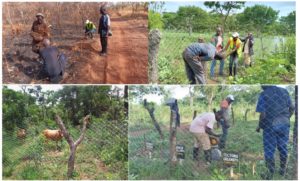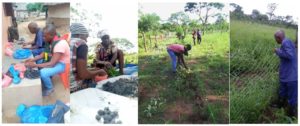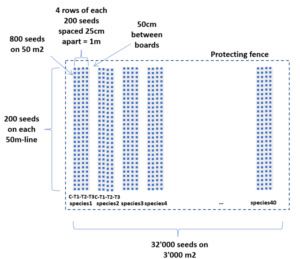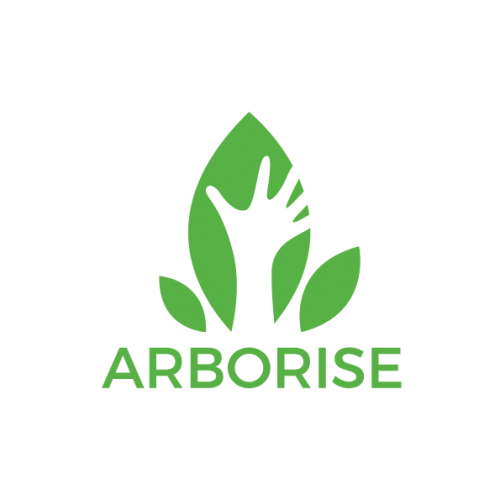Reforestation is one of the main ways to fight global warming. To be sustainable, reforestation projects must meet the needs of local communities and work with – not against – nature. And to be cost-effective, they must use local resources – especially seeds – and minimise the complexity of the reforestation process. Direct seeding with seed pellets is a solution that meets both these requirements. How big is the germination rate with seedballs? We were curious to understand this question.
For tropical species, the average germination rate under direct seeding is 38% and the establishment rate is 17% [1]. Establishment performance can be improved by protecting the seeds from natural predators. This is done with the seedball technique [2]. Coating seeds with a natural mixture of clay and charcoal can prevent up to 30% of losses to rodents, birds and pests. Seedballs are currently used in reforestation in Kenya and Ivory Coast [3], but the performance of the seed ball technique has never been scientifically measured for African tree species. Most scientific experiments [4] involving seedballs target crops such as wheat, etc., and not trees. With the support of the Research Challenge of ETH for Development, we wanted to fill this scientific gap by comparing the germination rate with and without the seedball technique. Indeed, according to our statutes, arboRise’s mission is “to experiment with natural reforestation methods that enhance biodiversity and to share the results of these experiments“.
Experimentation method
The objective is to verify the validity of hypothesis (1), according to which the seedball method [5] has a positive impact on the germination rate of 40 tropical forest species in the Linko region of Guinea. The impact of a pre-treatment to lift dormancy will also be evaluated.
The field experiment was conducted by our local partner, the NGO GUIDRE (Guinée Développement Rural et Environnement) in Faranah. Mr Pépé Philippe Kpogomou, an agricultural engineer and Prefectural Director of the Environment, Water and Forests in Kérouané and then in Faranah, supervised all the work and implementation.
The experiment was structured as follows:
- An experimental area of about 1 hectare was identified in Linko, cleared, and then surrounded by a 220m fence to prevent livestock from grazing on the shoots


- At the end of the harvest in each group of villages, 800 seeds of each species were collected. The seeds from the first and second groups were stored in sealed plastic bags until the seeds from the third group were harvested. Then all seeds were brought to Linko for pre-treatment.
- To compare the germination rate, from 11 to 13 May 2022, the 800 seeds per species were treated as follows:
- Control group: 200 seeds of each of the 40 species, without any pre-treatment or coating (“naked” seeds)
- Test Group 1: 200 seeds of each of the 40 species, with pre-treatment to break dormancy [6]
- Test Group 2: 200 seeds of each of the 40 species, without any pre-treatment but with a clay/charcoal coating
- Test Group 3: 200 seeds of each of the 40 species, with pre-treatment to break dormancy and with a clay/charcoal coating


- Then, on 14 May 2022, the groups of 200 seeds were sown with a line and a row spacing of 25cm between each seed and 50cm between each row. Each block of one species is separated from the block of the next species by 50cm. Each block is identified by a separate sign.


- The germination rate of each line was measured (shoots were counted) once on 18-19 July 2022 and again on 15-16 August 2022.
The results of the experiment are currently being analysed and will be published shortly. Thanks to ETH4D for its financial support and to the entire GUIDRE team for its ability to meet the challenges of the field!
[1] NurseryToForest Solutions; Grossnickle, S.; Ivetić, V.; University of Belgrade – Faculty of Forestry Direct Seeding in Reforestation – A Field Performance Review. REFOR 2017, 94–142, doi:10.21750/REFOR.4.07.46.
[2] Madsen, M.D.; Davies, K.W.; Boyd, C.S.; Kerby, J.D.; Svejcar, T.J. Emerging Seed Enhancement Technologies for Overcoming Barriers to Restoration: Emerging Seed Enhancement Technologies. Restor Ecol 2016, 24, S77–S84, doi:10.1111/rec.12332.
[3] www.seedballskenya.com , http://www.seedballsci.com/
[4] Gornish, E.; Arnold, H.; Fehmi, J. Review of Seed Pelletizing Strategies for Arid Land Restoration. Restor Ecol 2019, 27, 1206–1211, doi:10.1111/rec.13045.
[5] https://en.wikipedia.org/wiki/Seed_ball
[6] According to the guidelines in the catalogue de semences of the Centre National de Semences Forestières in Ouagadougou.

